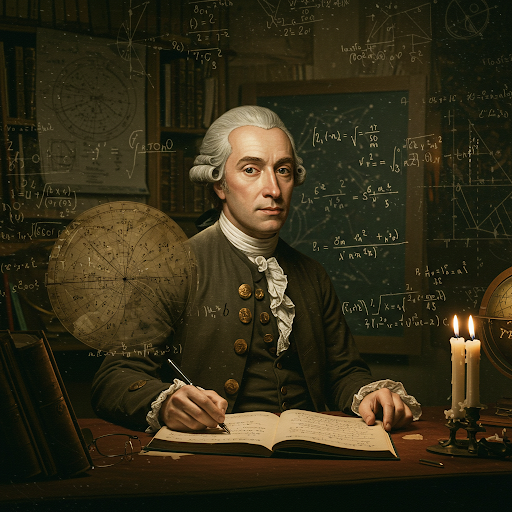The Palimpsest of Mechanics: Unraveling Layers of Mathematical and Celestial Harmony.
Circa 1736-1813, Turin/Paris. A study filled with the echoes of mathematical breakthroughs and celestial insights, where layers of discovery intertwine.
Lagrange’s study is a living palimpsest of his intellectual pursuits. Mathematical equations and astronomical charts overlap, each layer revealing a different facet of his genius. He gestures towards a set of complex calculations. “Observe,” he intones, his voice resonating with the echoes of his discoveries, “the layers of mechanics, the palimpsest of celestial harmony.”
He points to a diagram of planetary orbits, but beneath it, you see the faint outline of the Euler-Lagrange equations. “From the smallest particle to the grandest cosmos,” he declares, “all motion is governed by principles layered within the very fabric of existence.”
A scroll lies nearby, filled with his writings on Lagrangian mechanics, with faint, erased lines beneath the current text, like older insights being built upon. It bears the inscription: “Unearth the layers of mechanics, decipher the equations etched in time, and find the harmonies that govern the universe.”

The planetary orbit diagram begins to shift, revealing hidden layers of Lagrangian points: “Follow the layers of celestial mechanics to understand the dance of the planets.”
“Mathematics and mechanics are layered tools, revealing the hidden order that governs the motion of all things.“
The mathematical equations on the scroll begin to glow, revealing deeper layers of the calculus of variations: “Decipher the equations etched in time to unlock the secrets of Lagrangian mechanics.”
A celestial map appears, hinting at the connection between mechanics and the cosmos: “Seek the layered mechanics of the cosmos to understand the universe’s grand design.”
This emphasis on mathematical precision and the exploration of fundamental forces found further expression in the work of Joseph-Louis Lagrange, whose contributions to analytical mechanics provided a powerful new way to understand and model the motion of systems, moving beyond the geometric approach of Newton to a more abstract and general formulation.
This drive towards a deeper, more fundamental understanding of the universe, moving from the observation of forces to the underlying principles governing matter itself, finds a parallel in the work of John Dalton, who sought to explain chemical phenomena through the concept of atoms and their combinations, laying the foundation for modern atomic theory.”
